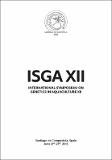Por favor, use este identificador para citar o enlazar a este item:
http://hdl.handle.net/10261/129766COMPARTIR / EXPORTAR:
 SHARE
BASE SHARE
BASE
|
|
| Visualizar otros formatos: MARC | Dublin Core | RDF | ORE | MODS | METS | DIDL | DATACITE | |

| Título: | Gene expression profile analysis of Manila clam (Ruditapes philippinarum) hemocytes after a Vibrio alginolyticus or Perkinsus olseni challenge using an immune-enriched oligo-microarray |
Autor: | Moreira, Rebeca CSIC ORCID; Romero Jódar, Alejandro CSIC ORCID; Milan, Massimo; Bargelloni, Luca; Novoa, Beatriz CSIC ORCID; Figueras Huerta, Antonio CSIC ORCID | Palabras clave: | Manila clam Hemocytes Vibrio alginolyticus Perkinsus olseni Microarray Immune response Gene ontology Blast2GO |
Fecha de publicación: | 2015 | Editor: | Universidad de Santiago de Compostela | Citación: | International Symposium on Genetics in Aquaculture (2015) | Resumen: | The Manila clam (Ruditapes philippinarum) is a cultured bivalve with worldwide commercial importance, and diseases in this species can cause high economic losses. For this reason, interest in the immune genes in this species has recently increased. The present work describes the construction of the first R. philippinarum microarray containing immune-related hemocyte sequences and the application of this microarray to study the gene transcription profiles of hemocytes from clams that were challenged with the bacteria Vibrio alginolyticus or the protistan parasite Perkinsus olseni through a time course. Our results highlight the importance of a fast response in bivalves and the effectiveness of their innate immune system. With regard to the V. alginolyticus challenge, genes related to signaling, transcription and apoptosis were typically expressed as early as 3 hours post-challenge (hpc), while characteristic immune genes appeared later at 8 hpc. This immune-triggering response could have affected a high number of processes that seemed to be activated 24 hpc to overcome the Vibrio challenge, including the expression of many cytoskeleton molecules, which is indicative of the active movement of hemocytes. In fact, functional studies showed an increment in apoptosis, necrosis or cell migration after the infection. Finally, 72 hpc, activity returned to normal levels. The results show that the key point to overcome the challenge seemed to be 8 hpc, when we detected immune functions that could lead to the destruction of the pathogen and the activation of a wide variety of processes related to homeostasis and defense. The analysis of the transcriptome profile after P. olseni infection revealed an early phase of infection (day 5) that was characterized by no mortality and by the increased expression of genes associated with pathogen recognition, production of nitrogen radicals and antimicrobial activity. This phase was followed by an intermediate stage (days 10 and 14), when the pathogen was most likely multiplying and infecting new areas of the body, and animals began to die. In this stage, many genes related to cell movement were over-expressed. Thirty days after infection metabolic pathway genes were the most affected. Apoptosis appears to be important during pathogenesis | Descripción: | Comunicación presentada en el XII International Symposium on Genetics in Aquaculture, Santiago de Compostela, 21-27 de junio de 2015 | Versión del editor: | http://isga2015.acuigen.es/isga-2015-Abstract-Book.pdf | URI: | 10261/129766 |
| Aparece en las colecciones: | (IIM) Comunicaciones congresos |
Ficheros en este ítem:
| Fichero | Descripción | Tamaño | Formato | |
|---|---|---|---|---|
| Gene_expression_profile.pdf | Presentación | 3,13 MB | Adobe PDF |  Visualizar/Abrir |
| Gene_expression_profile_abstract.pdf | Abstract | 69,91 kB | Adobe PDF |  Visualizar/Abrir |
CORE Recommender
Page view(s)
199
checked on 23-abr-2024
Download(s)
122
checked on 23-abr-2024
Google ScholarTM
Check
NOTA: Los ítems de Digital.CSIC están protegidos por copyright, con todos los derechos reservados, a menos que se indique lo contrario.
